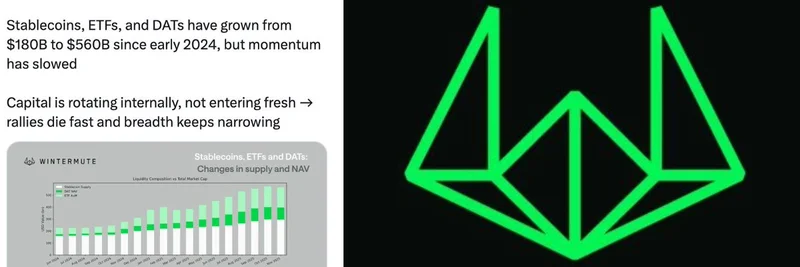In the fast-paced world of crypto, liquidity is like the fuel that keeps the engine running. Recently, a tweet from DegenerateNews spotlighted a crucial observation from Wintermute, a major player in crypto trading and market making. They pointed out that while liquidity has driven past crypto cycles, the inflow of new money has ground to a halt. This shift could explain why recent rallies fizzle out quickly and why the market feels narrower than ever.
Breaking Down Wintermute's Key Points
According to Wintermute's data as of November 5, 2025, the combined value of stablecoins, exchange-traded funds (ETFs), and digital asset treasuries (DATs) has ballooned from $180 billion to $560 billion since early 2024. That's a massive jump, but the momentum has slowed significantly. Stablecoins are digital currencies pegged to stable assets like the US dollar, providing a safe haven in volatile markets. ETFs, like those for Bitcoin and Ethereum, allow traditional investors to dip into crypto without holding the assets directly. DATs, or digital asset treasuries, refer to on-chain products that tokenize real-world assets like government bonds, offering yields in a blockchain format—think BlackRock's BUIDL or similar funds.
The problem? New capital isn't pouring in anymore. Instead, the money already in the ecosystem is just rotating between assets. Profits from one token, say Solana, might flow into meme coins, then back to major cryptos like Bitcoin. Without fresh inflows, rallies lack the staying power—they spike hard but crash just as fast. Market breadth, which measures how many assets are participating in the upside, keeps narrowing. Only a handful of top performers are moving, while the rest lag behind or bleed value.
Why This Matters for Meme Tokens
For meme token enthusiasts, this is particularly relevant. Meme coins thrive on hype, community momentum, and quick liquidity shifts. In a rotating capital environment, they can benefit from short-term pumps as traders chase the next hot thing. However, without new money entering the market, these pumps are unsustainable. We've seen this play out with tokens like Dogecoin or newer entrants—explosive gains followed by sharp corrections. Blockchain practitioners should watch stablecoin inflows closely, as they're one of the few areas still growing, potentially signaling where liquidity might head next.
Wintermute's analysis aligns with broader trends. Global liquidity is expanding thanks to rate cuts from central banks, but it's flowing into stocks, AI, and equities rather than crypto. ETF inflows have stalled, and DAT activity has dried up, leaving stablecoins as the main growth driver.
Looking Ahead in the Crypto Landscape
If you're building or investing in meme tokens, this stagnation highlights the need for innovation. Projects that attract real utility, strong communities, or ties to emerging narratives could buck the trend. Keep an eye on tools like Polymarket, which powers DegenerateNews, for betting on market outcomes and gauging sentiment.
In summary, Wintermute's warning is a wake-up call: crypto's recovery hinges on restarting those fresh capital inflows. Until then, expect more rotation, narrower rallies, and opportunities in niches like meme coins that can capture fleeting attention. Stay informed, and remember, in crypto, liquidity is king.


